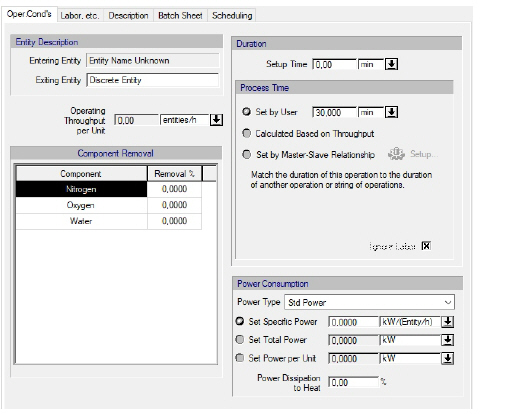

The following table shows a brief description of the variables appearing in this tab. The table also displays their default values and their generally acceptable range:
|
Variable |
Default Value |
Range |
|
|
||
|
● Entering Entity Description |
<Entity Name Unknown> |
Any Text |
|
○ Exiting Entity Description |
<Discrete Entity> |
Any Text |
|
● Operating Throughput per Unit (entities/h) |
0.0 |
Positive |
|
○ Removal % |
0.0 |
[0,100] |
|
○ Setup Time |
0.0 |
Positive |
|
◙ Process Time |
0.0 |
Positive |
|
○ Ignore Labor? |
Yes |
Yes/No |
|
○ Power Type |
<Std Power> |
Any Power Type |
|
◙ Specific Power (kW/(Entity/h)) |
0.0 |
Positive |
|
◙ Total Power (kW) |
0.0 |
Positive |
|
◙ Power Per Unit (kW) |
0.0 |
Positive |
|
○ Power Dissipation to Heat (%) |
0.0 |
[0,100] |
Symbol Key: ○ User-specified value (always input); ● Calculated value (always output); ◙ Sometimes input, sometimes output
The following list describes the available specification choices in this tab; for more details on how these are implemented, see Discrete Pass-Through/Bulk Separation: Modeling Calculations.
•Entity Description...
The description of the Entering Entity to the equipment is displayed. You may also specify a description for the Exiting Entity from the equipment that results from separation of bulk material.
•Duration Options...
You can set the process time (the sweeping time) or match the duration of this operation to the duration of another operation by introducing a master-slave relationship between the two operations. If you introduce a master-slave relationship, the program will match the setup time, the process time and the turnaround time of this operation (the ‘slave’) with the corresponding times of the reference operation (the ‘master’ operation). For more details on how to setup a master-slave relationship, see The Scheduling Tab.